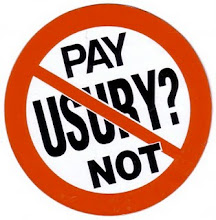UsuryFree Networks Growing

By Kerri Birtch - (Special to the Eye Opener)
“Thou shalt not take usury from another man,” reads one of our most read holy books. But somewhere in the last 100 years in particular, this notion has disappeared on our modern economy. The definition of usury is “the lending of money at exhorbitant interest rates.”
While most people have never heard the word before, its simplest translation is “interest.”
Nowadays, usury is everywhere. It comes with the bank loan you took out for your down payment; it comes with the mortgage on your house and the credit card you are working feverishly to pay off.
One way residents of rural Ontario are attempting to combat the pressures of usury is by ascribing to the ways of UsuryFree Networks and incorporating the use of community currency in their towns.
Tom J. Kennedy is a retired school teacher and a money reform activist, from Tamworth, Ontario. He became interested in usury back in the early 1980's when interest rates had hit 21-22 percent, he explains.
“I had a mortgage like everyone else, but I had to ask the question: How come the bank gets two houses and we only get one?” referring to the interest being paid on the mortgage.
He calls this problem, “the design flaw of usury” and it relates to the scarcity of federal cash.
According to Kennedy, the design flaw of usury is directly and/or indirectly responsible for much of the pain and suffering experienced by human beings living here on planet earth.
In truth, we are all paying for usury one way or another. Businesses with debt will often need to increase their retail prices in order to make up for their interest rates, therefore we the consumers are indirectly paying for usury. Rising interest rates cause inflation, which in turn, can cause financial distress for the rest of society.
The first usuryfree system was created by Michael Linton, of Comox Valley, on Vancouver Island, British Columbia. Following a local recession in 1982, Linton created the LETS (Local Employment Trading System) sofware. At the time local unemployment rates were roughly 25 per cent and so, the problem was that people had the skills, but there was no one who could afford to pay to use their services.
Thus, the LETSystem was born. According to Kennedy, the idea was to make a list of things you have and things you want. Then you negotiate a trade. If you had a large enough group of people, you would be able to survive without an abundance of federal cash.
Originally, in Canada, it was all done virtually by calling a system operator and reporting your trade, and then you would be mailed a paper statement, confirming the trade, much like a bank statement. In its first four years of existence the first LETSystem recorded $350,000. Of trading in greendollars that would not have taken place if these participants had relied entirely on hard, federal currency.
Since then, LETS has been spreading throughout the English speaking world. Linton called the virtual community currency “greendollars” after his vision of the environmental and social benefits that would follow general use of the system.
Now, however, the set up has changed to include printed pieces of community currency to make it easier for trades.
“Say you had a product that was worth $100. But the wholesale cost was really $60. In order to trade, someone would pay you the $60. In federal cash to cover your costs, then give you the rest in community currency.” explains Kennedy.
According to Wikipedia, the basics of LETS are that:
- Local people set up a club to trade among themselves, keeping their own record of accounts.
- A directory of members’ offers and requests - goods, services or items for hire, priced on local LETS units - is compiled and circulated.
- Members use the directory to contact one another whenever they wish. They pay for any service or goods by writing a LETS cheque or credit note for an agreed amount of LETS units, or by exchanging printed LETS notes.
- If applicable, the credit note is sent to the LETS book keeper who adjusts both members’ accounts accordingly.
- Unlike direct barter, with LETS members can earn credits from any member and spend them with anyone else on the scheme.
While the system will work just about anywhere that there are enough people who are willing to embrace it, Kennedy says it seems to work best in rural communities.
In Canada alone there are likely about 5000+ people using community currency.
Another example of the system at work was in 2001 after the economic crisis hit Argentina. A community currency was created and used by over seven million people.
One of the key components of successful usuryfree networks; “is that you take the federal cash you saved by using the network, and you pay off a debt of some kind. It’s the people who really understand the premise of it all that do this. We’re all paying interest on debt,” says Kennedy.
Much of the resistance from the general public probably: “comes from the belief that it is a ‘new idea.’ But what most don’t realize, is that our ancestors built our country on a similar system.” says Kennedy.
“Then there are those I call ‘watchers.’ They wait to see if it’s going to work first.”
If you’re ready to stop watching and start participating or you’d just like more information regarding the usuryfree movement, please contact: The UsuryFree Network, P. O. Box 9333, Ottawa, Ontario KiG 3V1 Tel: 1.888.NOUSURY Email: usuryfree@kos.net
Reprinted with permission from Vol. 4, No. 3, September 2006, The Kingston Eye Opener, P. O. Box 2154, Kingston, Ontario, Canada K7L 5J9 (Publisher/Editor: Geoff Matthews)


0 Comments:
Post a Comment
<< Home